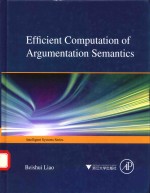
- 作 者:廖备水著
- 出 版 社:杭州:浙江大学出版社
- 出版年份:2015
- ISBN:9787308143257
- 标注页数:144 页
- PDF页数:154 页
请阅读订购服务说明与试读!
订购服务说明
1、本站所有的书默认都是PDF格式,该格式图书只能阅读和打印,不能再次编辑。
2、除分上下册或者多册的情况下,一般PDF页数一定要大于标注页数才建议下单购买。【本资源154 ≥144页】
图书下载及付费说明
1、所有的电子图书为PDF格式,支持电脑、手机、平板等各类电子设备阅读;可以任意拷贝文件到不同的阅读设备里进行阅读。
2、电子图书在提交订单后一般半小时内处理完成,最晚48小时内处理完成。(非工作日购买会延迟)
3、所有的电子图书都是原书直接扫描方式制作而成。
1 Introduction 1
1.1 Background 1
1.2 The Notion of Argumentation 2
1.3 Motivations of This Book 4
1.4 The Structure of This Book 6
References 7
2 Semantics of Argumentation 9
2.1 Introduction 9
2.2 Abstract Argumentation Frameworks 10
2.3 Argumentation Emantics 10
2.3.1 Extension-Based Approach 11
2.3.2 Labelling-Based Approach 17
2.3.3 Relations Between the Two Approaches 21
2.3.4 Relations Between Difierent Semantics 22
2.3.5 Status of Arguments 22
2.4 Conclusions 24
References 25
3 Existing Approaches for Computing Argumentation Semantics 27
3.1 Introduction 27
3.2 Approaches Based on Answer-Set Programming 28
3.2.1 Answer-Set Programming 28
3.2.2 ASP for Argumentation 29
3.3 Labelling-Based Algorithms 32
3.3.1 The Computation of Grounded Labelling 32
3.3.2 The Computation of Preferred Labellings 33
3.4 Conclusions 36
References 37
4 Sub-Frameworks and Local Semantics 39
4.1 Introduction 39
4.2 Notion of Sub-Frameworks 40
4.2.1 Informal Idea 40
4.2.2 Formal Definition 41
4.2.3 Dependence Relation Between Different Sub-Frameworks 43
4.3 Semantics of Sub-Frameworks 44
4.3.1 Labellings of a Conditioned Sub-Framework 44
4.3.2 Extensions of a Conditioned Sub-Framework 47
4.4 Computation of the Semantics of a Sub-Framework 50
4.5 Conclusions 53
References 53
5 Relations Between Global Semantics and Local Semantics 55
5.1 Introduction 55
5.2 Mapping Global Semantics to Local Semantics 57
5.3 Mapping Local Semantics to Global Semantics 60
5.3.1 Combining Extensions of Two Unconditioned Sub-Frameworks 61
5.3.2 Combining Extensions of a Conditioned Sub-Framework and Those of an Unconditioned Sub-Framework 63
5.3.3 Combining Labellings of Two Conditioned Sub-Frameworks 69
5.4 Conclusions 72
References 72
6 An Approach for Static Argumentation Frameworks 73
6.1 Introduction 73
6.2 Decomposing an Argumentation Framework:a Layered Approach 75
6.2.1 Strongly Connected Components(SCCs)of an Argumentation Framework 76
6.2.2 A Decomposition Approach Based on SCCs 76
6.3 An Incremental Approach to Compute Argumentation Semantics 81
6.3.1 The Computation ofLayer i(0≤i≤lmax) 81
6.3.2 Soundness and Completeness of Semantic Combination 84
6.3.3 An Illustrating Example 85
6.4 Empirical Evaluation 89
6.5 Conclusions 96
References 98
7 An Approach for Dynamic Argumentation Frameworks 101
7.1 Introduction 101
7.2 The Changing of an Argumentation Framework 105
7.3 The Division of an Updated Argumentation Framework 106
7.4 Computing the Semantics of an Updated Argumentation Framework Based on the Division 111
7.5 An Illustrating Example 112
7.6 Conclusions 114
References 116
8 An Approach for Partial Semantics of Argumentation 119
8.1 Introduction 119
8.2 The Definition of Partial Semantics of Argumentation 121
8.3 Basic Properties of Partial Semantics of Argumentation 124
8.3.1 Monotonicity of Partial Semantics 125
8.3.2 Extensibility of PartiaI Semantics 125
8.3.3 Combinability of Partial Semantics 128
8.4 Empirical Investigation 129
8.5 Conclusions 134
References 135
9 Conclusions and Future Work 137
9.1 Conclusions 137
9.2 Future Work 138
References 139
Index 141
